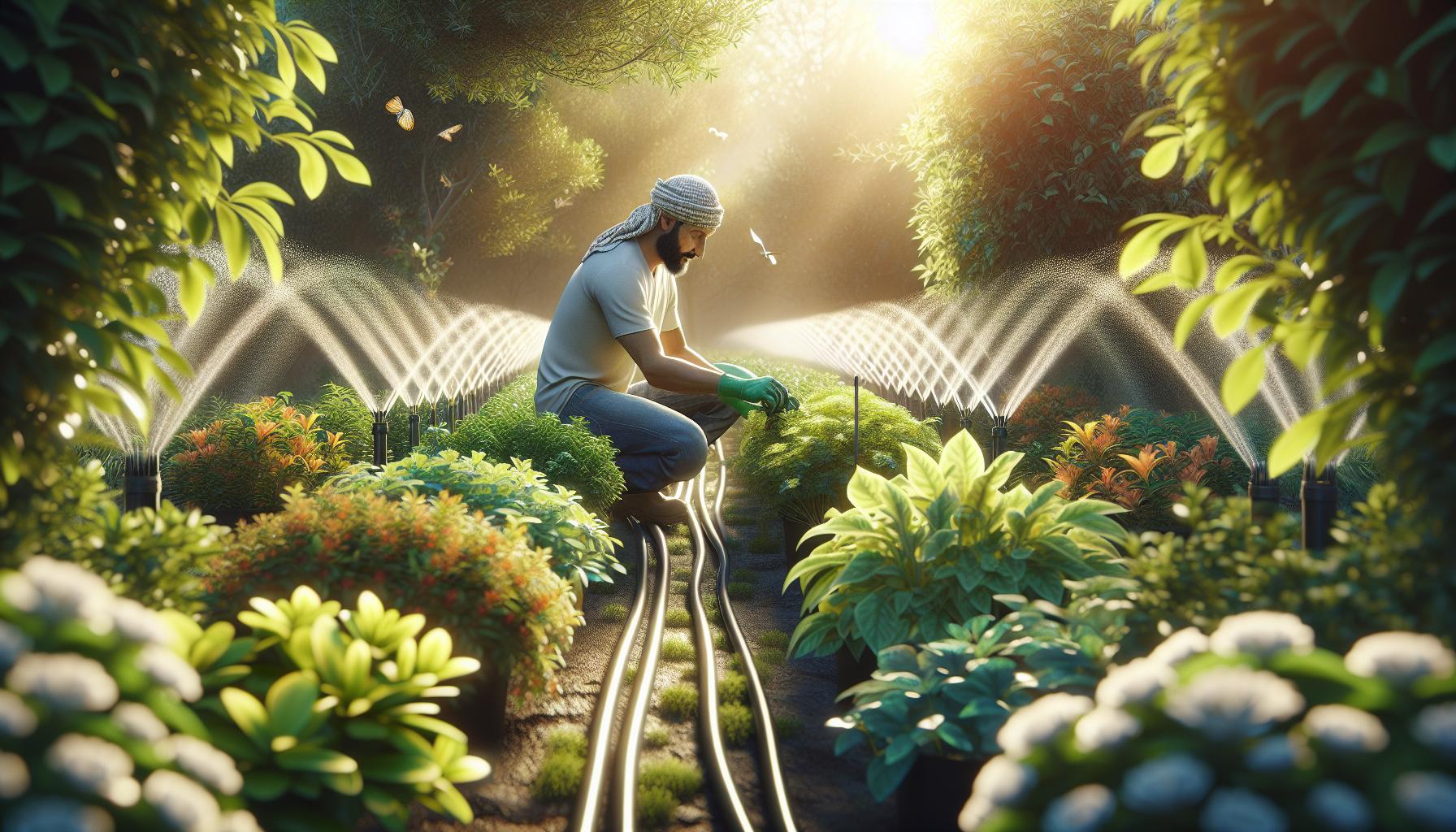Imagine a lush, thriving world that requires less water and energy to maintain. Drip irrigation offers this possibility by delivering water directly to plant roots, ensuring optimal hydration with minimal waste. This method is particularly beneficial for commercial properties where water conservation is a priority.
In this text, you’ll discover the key advantages of drip irrigation, from its water-saving capabilities to its positive environmental impact. Whether you’re looking to enhance your property’s sustainability or simply reduce maintenance costs, understanding these benefits can help you make an well-informed choice.
Understanding Drip Irrigation
What Is Drip Irrigation?
Drip irrigation, also known as trickle irrigation, is a type of micro-irrigation system. It efficiently delivers water directly to the plant roots, minimizing evaporation and waste. Water slowly drips through valves, pipes, tubes, or emitters, targeting the root zone. This method is more efficient than surface or sprinkler irrigation if well-designed and maintained. Drip irrigation systems conserve water and nutrients, making them a sustainable choice for your garden.
Convenient and Efficient
Drip irrigation systems are convenient and efficient. You can automate them with a timer, ensuring consistent watering. It saves you time and effort since you won’t need to manually water your plants.
Prevents Wasted Resource
This system minimizes water waste by delivering water directly to the roots. It helps preserve precious resources and ensures that plants get the necessary moisture without oversaturation.
Reduces Soil Erosion
Drip irrigation reduces soil erosion by applying water slowly and directly to the root zone. Unlike traditional irrigation methods, it prevents the displacement of soil and maintains the soil structure.
Versatile and Easy to Modify
Drip irrigation systems are versatile and easy to modify. You can customize them to fit any garden size or shape, change the layout, and add new emitters without significant hassle.
Reduces Energy Costs
These systems reduce energy costs. They operate at lower pressure compared to other irrigation methods. You’ll save on water bills and reduce energy consumption, making it an economically viable option.
Primary Advantages of Drip Irrigation

Increased Water Efficiency
Drip irrigation, a key modern method, significantly boosts water efficiency by delivering water directly to plant roots. This method minimizes evaporation and runoff, ensuring optimal water use. According to the University of Florida, drip irrigation systems can be up to 90% efficient, while traditional sprinkler systems generally achieve only 50-70% efficiency. This means you are conserving water, which is crucial in areas with water restrictions or during dry seasons.
Enhanced Plant Health and Growth
Direct delivery of water and nutrients to plant roots supports better plant health and growth. With drip irrigation, each plant gets the right amount of water, leading to healthier plants and higher yields. For instance, research by the University of California notes that efficient water delivery reduces plant stress and promotes consistent growth. This precise watering method prevents overwatering, which can lead to root rot and other plant diseases, safeguarding your garden’s vitality.
Reduced Weeds and Diseases
Drip irrigation systems reduce weed growth by targeting water delivery to plant roots rather than the soil surface. Since the soil surface remains dry, weeds have less chance to germinate and grow, reducing the need for weeding and herbicides. Also, dry soil surfaces help prevent the proliferation of soil-borne diseases that thrive in moist conditions. This targeted irrigation method not only keeps your garden healthier but also cuts down on labor and chemical use.
Economic and Environmental Benefits

Cost Savings Over Time
Drip irrigation offers significant cost savings over time. By delivering water directly to plant roots, this system ensures optimal water use, helping cut water bills. Traditional sprinkler systems, in contrast, can lead to water wastage and higher costs. Drip irrigation also reduces the need for fertilizers. By providing nutrients right where they’re needed, you prevent excess use, cutting down on costs. Also, the low pressure required for drip systems means lower energy consumption, reducing electricity or fuel expenses.
Conservation of Resources
Drip irrigation is a champion of resource conservation. This system, designed to deliver precise water amounts directly to plant roots, minimizes waste. It’s incredibly efficient, often achieving up to 90% efficiency compared to other methods that can be much less efficient. By reducing runoff and evaporation, you conserve water, a precious resource, especially in areas facing droughts.
Also, drip irrigation helps in conserving soil and nutrients. Unlike traditional methods that can cause soil erosion, drip systems maintain soil structure, preventing nutrient loss. This method also minimizes weed growth by keeping water away from unwanted areas, reducing the need for herbicides. Overall, drip irrigation not only saves water and money but also promotes a healthier environment by conserving essential resources.
Versatility and Application

Suitable for Diverse Landscapes
Drip irrigation adapts well to various world designs, whether you have a flat garden, a hillside, or an irregular plot. You can arrange the drip lines to specifically target different plant types and optimize water usage. This system works for flower beds, vegetable gardens, shrubs, and even trees. For example, a garden with both high-water-demand plants and low-water-demand plants can benefit from the precise control that drip irrigation offers. Each plant group can receive the exact amount of water needed without oversaturation.
Easy Integration and Modification
Installing a drip irrigation system can be done in phases, allowing you to start with key areas and expand later without disrupting your existing world. The flexibility of drip irrigation also means you can easily modify the system as your garden changes. If you add new plants, simply extend the drip lines to the new locations. Adjusting the emitters to change the water flow rate is straightforward, helping to ensure that plants continue to receive adequate water as they grow. Plus, connecting the system to an automatic timer can save you from manual watering, offering convenience and consistency.
Drip irrigation consistently provides tailored water distribution, eliminating water waste and promoting healthier plant growth across varied landscapes.
Conclusion

Drip irrigation provides numerous advantages for both home gardeners and commercial growers. By delivering water directly to plant roots, it boosts water efficiency, achieving up to 90% effectiveness compared to traditional sprinkler systems. This method ensures that your plants get the right amount of water and nutrients, promoting healthier plant growth and reducing stress.
Using drip irrigation reduces plant diseases such as root rot and limits weed growth by keeping the soil surface drier. These benefits significantly lower the incidence of soil-borne diseases, resulting in a healthier garden or world.
Economic benefits include reduced water bills, fertilizer use, and energy consumption. This system minimizes water waste, runoff, and evaporation, helping you save on resources while maintaining soil structure and nutrients.
Drip irrigation is versatile and can be applied to a variety of landscapes, whether you have a flat garden, hillside terrain, or irregular plot. It allows for precise water distribution tailored to different plant types, ensuring optimal water use for each plant.
You can install drip irrigation in phases, making it easy to expand without disturbing existing plants. As your garden evolves, the system’s flexibility permits ongoing adjustments, ensuring your plants always receive adequate water.
Overall, drip irrigation offers a sustainable, efficient, and adaptable solution for conserving water, promoting plant vitality, reducing maintenance, and fostering a healthier environment. Its ability to provide customized water distribution makes it a preferred choice for diverse landscapes, eventually supporting robust plant growth and reduced resource use.

